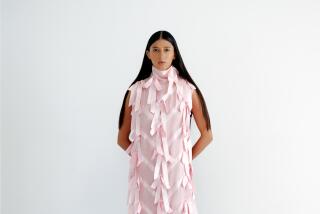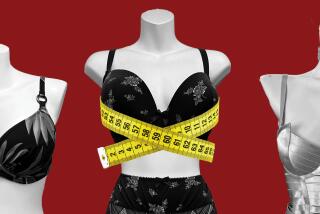From Rags to Stitches
- Share via
QINGDAO, China — Sun Yianxiang took her daughter to buy her first bra in a department store when the teenager was in high school. There were plenty of choices. Sun, however, didn’t even know what a real bra looked like until she was almost 40.
“Our idea of a bra was a cotton tank top or something we would sew ourselves out of a piece of plain fabric,” said Sun, now 50 and a department store executive in Inner Mongolia. “Some of us would cut a scoop or V-neck into it. That would be considered fancy.”
It wasn’t until 1993 that she saw a lacy contraption with bright colors and underwire support during a business trip to the trendsetting southern city of Shenzhen, among the first areas to open to foreign influence.
“I’d never seen anything like it before,” Sun said. “I thought it had to be the most beautiful thing in the world. I just had to buy it.”
In the West, some see hemlines as an indicator of how the economy is doing -- the higher the hem, the better the times. In China, it’s the brassiere drawer.
“Underwear development in China went hand in hand with our country’s economic development,” said Song Yuhui, the new product development manager for Aimer, China’s biggest domestic bra maker. “Before, the only thing on the market was simple bras made of thin white cotton. Women accepted it because they didn’t know any better.
“Today, as people’s purchasing power has grown, women are accepting the idea that underwear can match outfits, different colors are good for different seasons, what you wear to a party could be different from what you wear to bed,” she said. “But it took us some time to get to this point.”
Until a recent trade dispute between Washington and Beijing ignited what the Western media dubbed the battle of the bras, few outside the industry had noticed that, like so many other things these days, the bulk of the world’s production of women’s underwear had moved to China.
But even as sparks fly over whether to use lingerie quotas to address the more than $110-billion trade surplus China enjoys over the United States, another Chinese cultural revolution is quietly taking shape.
Within years, China has gone from being a source of cheap labor for foreign lingerie companies to a formidable consumer of its own feminine creations. A burgeoning bra industry has moved with dazzling speed to remove the bandage-like cotton straps from the national wardrobe and replace them with Victoria’s Secret wannabes that are changing the way Chinese women dress -- and look.
The first to take advantage of the fancy new undergarments were working urban women with thickening pocketbooks. But with prices for intimate wear ranging from less than a dollar in curbside markets to more than $40 in fancy boutiques, just about any woman can afford to indulge.
“My mother now owns more expensive bras than I do,” said Sun’s daughter Liu Rong, now 24 and just beginning a job at Aimer as a public relations officer. (Her mother acknowledged that she pays more than $38 for the finest satin or embroidered brassiere with matching panties.) “When she was young she didn’t have anything like that, so she wants to make it up to herself.”
The idea of the shapely modern brassiere entered the Chinese consciousness in the 1930s through Hollywood movies. Until then, the Chinese were used to women concealing their curves. The first bras sold in China came by boat from France, then Russian immigrants in Shanghai built a reputation by popularizing made-to-order styles.
But soon after the Communist revolution in 1949, lacy underwear, along with silk stockings and permed hair, was banished as part of a forbidden lifestyle associated with bourgeois materialism. A whole generation grew up ignorant of fashion.
The collapse of those taboos has fueled a multibillion-dollar industry that is growing by 20% a year. According to one Chinese study, there are more than 5,000 underwear producers around the country, with a combined annual revenue of about $6 billion. The industry is expected to expand tenfold within five years.
Such success was far from assured a decade ago when China’s first domestic bra maker began business. Beijing-based Aimer was a tiny neighborhood operation assembling Japanese- designed underwear for export until orders dried up and the workers faced losing their jobs. A young college graduate from a steel academy who was fascinated by the underwire technology of ladies’ brassieres decided to take a plunge and start his own business by taking over what was left of the little factory.
“He was the first Chinese person to want to make our own bra with our own brand name,” Song said, referring to company founder and Chief Executive Zhang Rongming. “It was not easy at the time because Chinese women knew next to nothing about bras. They saw it as something whose sole function was to cover up the body. They didn’t know anything about stretch fabric, supporting wires, shape and a sense of fashion.”
Even the idea of shopping for underwear turned most women off. Simple as they were, bras were usually stocked like all other consumer goods, from soy sauce to socks, under glass counters guarded by sales clerks who cared little about service. There was no reliable sizing system and no way to try the garments on.
Sometimes women ran into uncomfortable situations when clerks tried to be helpful. One store in Shanghai allowed sales ladies to grab the customer’s breast to help determine size. A more discreet shop might hire an elderly woman to sit behind velvet curtains to feel the customer before suggesting a purchase.
Today, Aimer produces 500 million undergarments a year with at least 200 seasonal styles and color variations based on an international size chart. Its products fill entire floors in department stores across the country. Women can try them on in private fitting rooms without unwanted touching.
Zhuang Fei has never seen a Victoria’s Secret catalog or opened a newspaper filled with Maidenform ads. For most of her life, the worker at the Qingdao Nannan factory here on China’s bustling east coast had no idea that the cloth covering a woman’s chest could come in so many sizes, styles and colors. Now, thousands of brassieres go through her hands every week before they are shipped out of the country and sold overseas.
“We’ve made push-up bras with thick padding good for women with very small busts and we’ve made extra-large ones that are bigger than my head. It’s really very funny,” said Zhuang, 23, looking up from a heap of pink seamless Maidenforms. “Before I started working here I rarely paid attention to these things. Now, when I go bra shopping, I always try to find the most colorful ones and something that looks like what we make here.”
Chances are, she won’t be able to find the same ones. The top brands at her factory, where she inspects products for stitching irregularities, are Maidenform, Victoria’s Secret and Target brands. They are much more likely to end up on supermodel Tyra Banks than on a Chinese seamstress who makes about $3 a day.
Top-of-the-line bras sold in China cost more than many people in this largely rural country make in a year.
“Nobody I know can afford this kind of quality,” said Zhang Feng, 21, another assembly-line worker at Qingdao Nannan, as she zipped through a pile of apple-green bras with her sewing machine. “Anything that looks like this would cost at least $2.50 each. What I buy costs me only 60 cents.”
Most of her co-workers are peasants’ daughters. For them, the job at the bra factory not only brings more money than their parents could ever make, but it also opens a window into the world of beauty they never suspected existed, a world the trade battles have jeopardized.
After the Bush administration in November limited the import of Chinese bras, dressing gowns and knit fabric, Qingdao Nannan laid off 350 people, or about 17% of its staff. The company had planned on hiring 300 more people for a much-anticipated expansion, and that also was scrapped. More workers may have to leave if things don’t improve, said Christopher Moon, chairman of the South Korea-based company.
Moon has already moved most of his Victoria’s Secret production to Indonesia. If his other U.S.-bound orders dry up, he may start producing his popular South Korean brand in Qingdao for the Chinese market.
“This would be something we’ve been thinking about for the last three years,” Moon said from his office in Qingdao. “Korean culture is very popular in China now. China could soon become the second-strongest economy in the world. You’d be crazy not to do business with China.”
That would, of course, mean more competition for Chinese-owned bra makers.
“There’s already a mad dash into the market with thousands of brands out there,” said Song of Aimer. “But our style is more suitable to the Chinese taste. We have conducted special research and we know what our customers want. They have gone from no-function bras to function mania. If the bra doesn’t improve their look, they will simply not buy it.”
Studies show Chinese women still buy far less fancy underwear than their Western counterparts. For them, the most likely occasions for purchasing a new bra are their wedding day and their special birthdays that come once every 12 years on the Chinese calendar. Both days are celebrated by wearing red undergarments for good luck. Chinese women today are more likely to splurge on visible items such as cosmetics or a coat.
“When I go to the sauna or the spa, I am often embarrassed to see women with beautiful clothes undress to reveal raggedy and ill-fitting underwear more appropriate for an older housewife,” said Sun, the department store executive. “They don’t realize that to look good and feel confident, the quality of what goes on the inside has to be just as good as what goes on the outside.”






